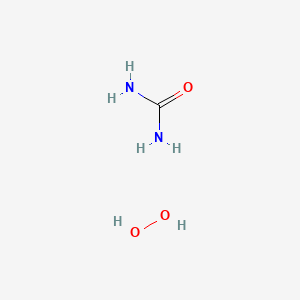



1. Hydrogen Peroxide, Urea
2. Perhydrol Urea
3. Urea Hydrogen Peroxide
4. Urea Peroxide
1. Urea Hydrogen Peroxide
2. 124-43-6
3. Percarbamide
4. Urea Peroxide
5. Urea Dioxide
6. Urea Hydroperoxide
7. Hydroperit
8. Hydroperite
9. Percarbamid
10. Perhydrit
11. Thenardol
12. Hyperol
13. Ortizon
14. Perhydrol-urea
15. Hydrogen Peroxide Carbamide
16. Hydrogen Peroxide Urea
17. Murine Ear Drops
18. Urea Compound With Hydrogen Peroxide (1:1)
19. Carbamide Peroxide, Solution
20. Hydrogen Peroxide;urea
21. Hydrogen Peroxide-urea Adduct
22. Urea Hydrogen Peroxide Adduct
23. Urea, Compd. With Hydrogen Peroxide (1:1)
24. Carbamide Peroxide [usp]
25. Urea, Compd. With Hydrogen Peroxide (h2o2) (1:1)
26. 31pz2vau81
27. Chebi:75178
28. Nsc-24852
29. Carbamide Peroxide (usp)
30. 14479-85-7
31. Hydrogen Peroxide; Urea
32. Proxigel
33. Debrox
34. Gly-oxide
35. Thera-ear
36. Ear Wax Treatment
37. Ureahydrogenperoxide
38. Auro Ear Wax Remover
39. Einecs 204-701-4
40. Nsc 24852
41. Un1511
42. Unii-31pz2vau81
43. Per Carbamide
44. Hydrogen Peroxide, Compd. With Urea (1:1)
45. Carbamide Peroxide Otic Solution
46. Mfcd00013119
47. Urea-hydrogen Peroxide
48. Urea.h2o2
49. Hydrogen Peroxide.urea
50. H2o2 Urea
51. Murine Ear Drops (tn)
52. Dsstox_cid_4726
53. Wln: Zvz & Qq
54. Dsstox_rid_77512
55. Dsstox_gsid_24726
56. Hydrogen Peroxide Urea Adduct
57. Urea Peroxide [inci]
58. Urea Hydrogen Peroxide, 97%
59. Carbamide Peroxide [mi]
60. Chembl3184026
61. Dtxsid9024726
62. Carbamide Peroxide [vandf]
63. Hydrogen Peroxide - Urea (1:1)
64. Urea, Compd. With Peroxide (1:)
65. Nsc24852
66. Tox21_302451
67. Urea Compound With Hydrogen Peroxide
68. Hydrogen Peroxide-urea Adduct, Tablet
69. Akos015904087
70. Db11129
71. Hydrogen Peroxide Urea ;perhydrol-urea
72. Hydrogen Peroxide-urea Compound (1:1)
73. Urea Hydrogen Peroxide (1:1)
74. Urea Hydrogen Peroxide [mart.]
75. Urea Hydrogen Peroxide [who-dd]
76. Ncgc00256660-01
77. (h2 N)2 C O (h2 O2)
78. Carbamide Peroxide [usp Monograph]
79. Cas-124-43-6
80. Hydrogen Peroxide, Compd. With Urea(1:1)
81. Urea, Compd. With Hydrogen Peroxide(1:1)
82. D03383
83. Urea Hydrogen Peroxide [un1511] [oxidizer]
84. A805233
85. J-005078
86. J-525152
87. Q-200793
88. Q2633879
89. Hydrogen Peroxide-urea Adduct, Usp, 96.0-102.0%
90. Hydrogen Peroxide-urea Adduct, Powder, 15-17% Active Oxygen Basis
91. Hydrogen Peroxide-urea Adduct, Purum P.a., "rapid-soluble", Tablet (1 G Each)
92. Uhp
| Molecular Weight | 94.07 g/mol |
|---|---|
| Molecular Formula | CH6N2O3 |
| Hydrogen Bond Donor Count | 4 |
| Hydrogen Bond Acceptor Count | 3 |
| Rotatable Bond Count | 0 |
| Exact Mass | 94.03784206 g/mol |
| Monoisotopic Mass | 94.03784206 g/mol |
| Topological Polar Surface Area | 110 Ų |
| Heavy Atom Count | 6 |
| Formal Charge | 0 |
| Complexity | 29 |
| Isotope Atom Count | 0 |
| Defined Atom Stereocenter Count | 0 |
| Undefined Atom Stereocenter Count | 0 |
| Defined Bond Stereocenter Count | 0 |
| Undefined Bond Stereocenter Count | 0 |
| Covalently Bonded Unit Count | 2 |
Indicated as a dental bleaching agent. Indicated as an oral wound healing agent in oral mucosal injuries. Indicated as an aid in the removal of hardened ear wax.
Carbamide peroxide releases hydrogen peroxide and free radicals upon contact with water or outer surfaces of ear and tooth. Hydrogen peroxide exerts cerumenolytic, enamel-bleaching and antiseptic actions. _In vitro_, the chemical stability of ceramics against bleaching agents was observed after treatment with 15% carbamide peroxide for 56 h, 16% carbamide peroxide for 126 h, 10% or 15% carbamide peroxide and 38% hydrogen peroxide for 30 minutes or 45 minutes, respectively. According to _in vitro_ studies, high (37%) or low (10 or 16%) concentrated carbamide peroxide agents were similarly effective as oral bleaching agents. Treatment with carbamide peroxide may lead to demineralization which involves decreased mineral content of enamel calcium, phosphate, and fluoride, and alteration of the chemical, structural, and mechanical properties. Carbamide peroxide may affect the organic components of the enamel and lead to increased susceptibility to erosion, fracture stability or decreased abrasion resistance of the treated area.
Anti-Infective Agents, Local
Substances used on humans and other animals that destroy harmful microorganisms or inhibit their activity. They are distinguished from DISINFECTANTS, which are used on inanimate objects. (See all compounds classified as Anti-Infective Agents, Local.)
Tooth Bleaching Agents
Chemicals that are used to oxidize pigments in TEETH and thus effect whitening. (See all compounds classified as Tooth Bleaching Agents.)
Absorption
Upon treatment into the external auditory canal or the dental cavity, exposure to carbamide peroxide is limited to the intimate contact with the treated area without any systemic absorption.
Route of Elimination
No established pharmacokinetic data.
Volume of Distribution
No established pharmacokinetic data.
Clearance
No established pharmacokinetic data.
No established pharmacokinetic data.
No established pharmacokinetic data.
Carbamide peroxide release hydrogen peroxide upon contact with teeth, which is a strong oxidizing and bleaching agent. It also release free radicals such as H+ or H3O+. Hydrogen peroxide also acts as an antiseptic, especially in sites with relative anaerobiosis. Following otic administration, carbamide peroxide complex releases hydrogen peroxide that breaks up the hardened wax. The hydrogen peroxide component, which further breaks down into water, is also a cerumenolytic that hydrates the desquamated sheets of corneocytes, which are the major constituent of cerumen plugs. The glycerol and urea facilitates softening of the cerumen, either with or without syringing. Both hydrogen peroxide and urea mildly induce keratolysis with disintegration of the ear wax to help reduce the keratin-load in the ear debris and allow other active components to reach the skin under the debris.